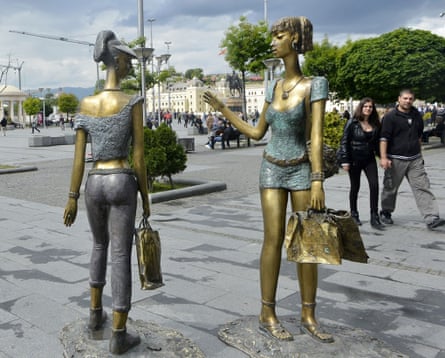Walk along the river towards the heart of Skopje, the Republic of Macedonia’s capital, and you’ll quickly find yourself among a host of gleaming, neo-classical buildings, complete with ornate columns and rooftop figures of nymphs. The buildings weren’t there five years ago.
In early April, the riverside bars are just shaking off the cobwebs of winter, returning tables and chairs to terraces that look out over many of the new structures. Bridges lined with pristine statues of Macedonian heroes, writers and artists cross the slow-moving waters of the Vardar river.
Long a forgotten corner of Europe, the former Yugoslav republic has gone into overdrive since 2010, erecting huge government and civic buildings as well as hundreds of statues in the heart of its capital. Now almost complete, the project, known as Skopje 2014 (it was meant to be finished last year), is just as intriguing and arguably as divisive as it was when first announced.
The project has two main aims: to draw in more tourists and to try to reclaim aspects of the country’s history from neighbouring Greece, appealing to the patriotism of many ethnic Macedonians. It has cost somewhere between €200-€500m (depending on who you talk to) and has resulted in a completely new-look city centre.
“It’s very kitsch, but it’s bringing in visitors,” says Oliver Stefanovski, the manager at Unity Hostel, right on the edge of the new development.

Many Macedonians are questioning the scheme’s vast public expense – not to mention its aesthetic qualities. There is also controversy over the way it ignores much of the role of the Muslim Albanian community in the country’s history. But there’s no doubting it has put the city on the tourist map, aided by the arrival of budget flights from Wizz Air.
At the heart of the new-look city centre is a 22-metre-high bronze statue of Alexander the Great, encircled by warriors and a fountain that’s at the centre of nightly light shows. Nearby, statues of former rulers and saints seem to be crammed by the dozen into all available spaces, along with the city’s own arc de triomphe.
Across the river from Alexander, a towering statue of Philip of Macedonia, hand raised to the heavens, stares back. “I definitely prefer this new area of the city to the old area. It shows our history,” says Aneta Gakovska, the owner of a small local restaurant.
Foreign visitors used to come to Skopje primarily to wander around the beautiful Old Bazaar district, with its alleys, mosques and old hilltop fort. But now they can go in less than five minutes from drinking a Turkish coffee among people and architecture that wouldn’t be out of place in a traditional city of the Middle East, to being surrounded by faux-classical European architecture and imagery.
Opinions may be divided over it, but the Skopje 2014 project has certainly made the city one of Europe’s more unorthodox capitals to visit.

Comments (…)
Sign in or create your Guardian account to join the discussion